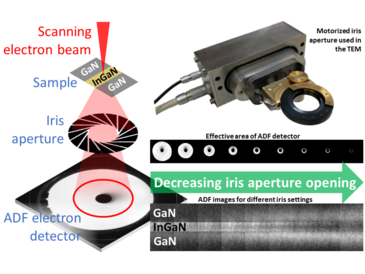Tim Grieb, Florian F.Krause, Knut Müller-Caspary, Jan Philipp Ahl, Marco Schowalter, Oliver Oppermann, Joachim Hertkorn, Karl Engl, Andreas Rosenauer
Ultramicroscopy 238 (2022): 113503
https://doi.org/10.1016/j.ultramic.2022.113535
In this paper we perform angular resolved annular-dark field (ADF) scanning-transmission electron microscopy (STEM) to study the scattered intensity in an InGaN layer buried in GaN as a function of the scattering angle. We achieved angular resolution with a motorized iris aperture in front of the ADF detector. Using this setup, we investigated how the intensities measured in various angular ranges agree with multislice simulations in the frozen-lattice approximation. We observed a strong influence of relaxation induced surface-strain fields on the ADF intensity, measured its angular characteristics and compared the result with simulations.
To assess the agreement of the measured intensity with simulations, we evaluated the specimen thickness in GaN and the indium concentration in InGaN for each angular interval by comparing the measured intensities with simulations. The thickness was strongly overestimated for scattering angles below 40 mrad and also the evaluated indium concentration varies with the considered angular range. Using simulations, we investigated which angular ranges show a high sensitivity to variations of the thickness and which intervals strongly depend on the indium concentration. By combining two angular intervals, the indium concentration and the specimen thickness were determined simultaneously, which has potential advantages over the usual quantification method. It is shown that inelastic scattering, surface contamination and mistilt can have an influence on the measured intensity, especially at lower scattering angles below 30–50 mrad, which might explain the observed difference between the frozen lattice simulation and the experiment.


